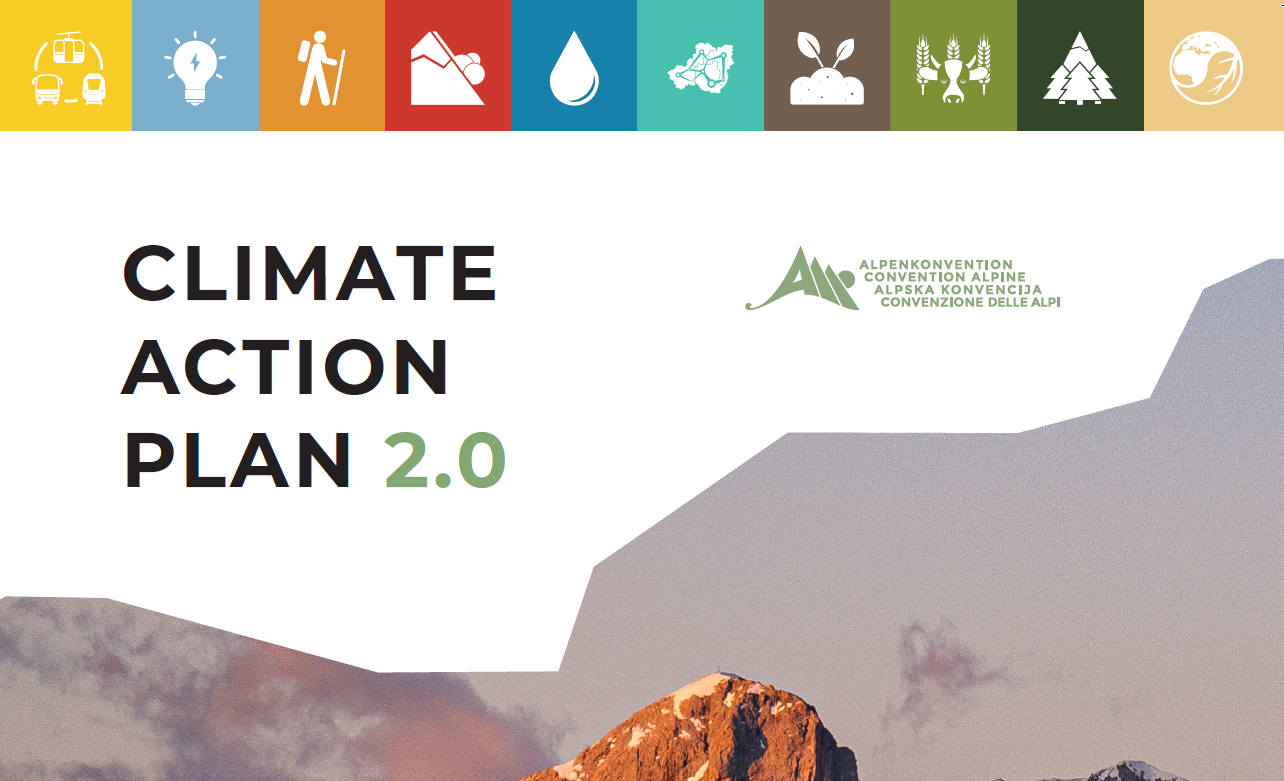
CLIMATE ACTION PLAN 2.0
The Climate Action Plan 2.0 operationalises the objectives laid out in the Alpine Climate Target System 2050, a strategy focused on the added value of Alpine-wide cooperation on climate change mitigation and adaptation. The Climate Action Plan 2.0 was adopted by the XVI Alpine Conference in December 2020.
It seeks out synergies between different activities across sectors and borders, closing the gaps between actions and activities in order to address climate change – one of the most pressing challenges in the Alps.
The implementation pathways that lie at the heart of this document contribute to the goal of reaching climate-neutral and climate-resilient Alps by 2050.
The Climate Action Plan 2.0 was developed by the ACB during the working period 2019-2020 and prioritises specific measures to implement the Alpine Climate Target System 2050 in the ten sectors of activity; the horizontal topics (municipal action as well as research and development) are integrated in the sectoral proposals. The Climate Action Plan 2.0 focuses on the medium-term horizon (next five to ten years) and proposes detailed implementation pathways, which are about to be launched or can be launched within the next one to two years to be further developed until 2030.
Implementation pathways are at the core of the Climate Action Plan 2.0: the pathway approach ensures a smart sequencing and combination of measures and identifies measures with re-enforcing impacts. All implementation pathways were developed in a stakeholder approach, integrating inputs and ideas from various stakeholder groups during workshops, feedback rounds and expert interviews. The Thematic Working Bodies of the Alpine Convention were deeply involved in the process and they will further play a significant role in the implementation of the pathways.
Through the involvement of representatives of all Alpine States, the underlying implementation pathways and the Climate Action Plan 2.0 take into account the existing regional, national and transnational programmes and measures that are being implemented in various Alpine countries. In addition, good practices developed by Observer organisations and other relevant stakeholders were considered.
The Climate Action Plan 2.0 does not have the objective to duplicate ongoing activities. It shall rather ensure synergies between the different activities and close missing links, especially targeting cross-border action.
Under this approach, the ACB developed between two and four implementation pathways for each sector. Altogether 30 implementation pathways were designed.
The Climate Action Plan 2.0 calls for joint activities across sectors and borders, closing the implementation gap between strategies and actions in order to address climate change.
Download the Climate Action Plan 2.0 here (also available in French, German, Italian, Slovenian)
Ten implementation communities are now taking on the Climate Action Plan 2.0 – stay tuned for further news!
Print copies of the report without the annex are available upon request from the Permanent Secretariat of the Alpine Convention.

THE PREFACE – “HOPE IS NOT A STRATEGY”
Vince Lombardi, original source unknown
We, the undersigned, fully subscribe to this quote – indeed, we are not only hoping but are rather counting on innovative ideas and solutions to combat climate change! To demonstrate this, the Alpine Climate Target System 2050 and the Climate Action Plan 2.0 have been developed as part of a broader strategy towards climate-neutral and climate-resilient Alps by 2050.
Climate change requires immediate action in all sectors including energy, transport, mountain agriculture, tourism, spatial planning and soil – to name but a few. Gaining momentum through the adoption of the Alpine Climate Target System 2050 and the Climate Action Plan 2.0 by the Alpine Conferences in 2019 and 2020, the Alpine Climate Board (ACB) is now ready to move into the implementation phase.
The ACB has developed 30 implementation pathways for ten different sectors, which are available on alpineclimate2050.org and alpconv.org. The following pages provide information on the pathways considered priorities by the Ministers of the Alpine states.
Now is the time to join forces and take concrete steps together towards implementing our climate goals! Building strong and effective partnerships will be key to ambitious climate action, especially in the Alps with their specif ic challenges and characteristics. Moreover, we will continue to work closely with all partners in the Alpine Convention family and beyond to spur swift action in implementing our strategy.
Alenka Smerkolj, Secretary General of the Alpine Convention
Helmut Hojesky, Chair of the Alpine Climate Board of the Alpine Convention
Silvia Jost, President of the Permanent Committee of the Alpine Conference 2021-2022
CLIMATE ACTION PLAN 2.0
The Climate Action Plan 2.0 operationalises the objectives laid out in the Alpine Climate Target System 2050, a strategy focused on the added value of Alpine-wide cooperation on climate change mitigation and adaptation. The Climate Action Plan 2.0 was adopted by the XVI Alpine Conference in December 2020.
It seeks out synergies between different activities across sectors and borders, closing the gaps between actions and activities in order to address climate change – one of the most pressing challenges in the Alps.
The implementation pathways that lie at the heart of this document contribute to the goal of reaching climate-neutral and climate-resilient Alps by 2050.
The Climate Action Plan 2.0 was developed by the ACB during the working period 2019-2020 and prioritises specific measures to implement the Alpine Climate Target System 2050 in the ten sectors of activity; the horizontal topics (municipal action as well as research and development) are integrated in the sectoral proposals. The Climate Action Plan 2.0 focuses on the medium-term horizon (next five to ten years) and proposes detailed implementation pathways, which are about to be launched or can be launched within the next one to two years to be further developed until 2030.
Implementation pathways are at the core of the Climate Action Plan 2.0: the pathway approach ensures a smart sequencing and combination of measures and identifies measures with re-enforcing impacts. All implementation pathways were developed in a stakeholder approach, integrating inputs and ideas from various stakeholder groups during workshops, feedback rounds and expert interviews. The Thematic Working Bodies of the Alpine Convention were deeply involved in the process and they will further play a significant role in the implementation of the pathways.
Through the involvement of representatives of all Alpine States, the underlying implementation pathways and the Climate Action Plan 2.0 take into account the existing regional, national and transnational programmes and measures that are being implemented in various Alpine countries. In addition, good practices developed by Observer organisations and other relevant stakeholders were considered.
The Climate Action Plan 2.0 does not have the objective to duplicate ongoing activities. It shall rather ensure synergies between the different activities and close missing links, especially targeting cross-border action.
Under this approach, the ACB developed between two and four implementation pathways for each sector. Altogether 30 implementation pathways were designed.
The Climate Action Plan 2.0 calls for joint activities across sectors and borders, closing the implementation gap between strategies and actions in order to address climate change.
Download the Climate Action Plan 2.0 here (also available in French, German, Italian, Slovenian)
Ten implementation communities are now taking on the Climate Action Plan 2.0 – stay tuned for further news!
Print copies of the report without the annex are available upon request from the Permanent Secretariat.
THE PREFACE – “HOPE IS NOT A STRATEGY”
Vince Lombardi, original source unknown
We, the undersigned, fully subscribe to this quote – indeed, we are not only hoping but are rather counting on innovative ideas and solutions to combat climate change! To demonstrate this, the Alpine Climate Target System 2050 and the Climate Action Plan 2.0 have been developed as part of a broader strategy towards climate-neutral and climate-resilient Alps by 2050.
Climate change requires immediate action in all sectors including energy, transport, mountain agriculture, tourism, spatial planning and soil – to name but a few. Gaining momentum through the adoption of the Alpine Climate Target System 2050 and the Climate Action Plan 2.0 by the Alpine Conferences in 2019 and 2020, the Alpine Climate Board (ACB) is now ready to move into the implementation phase.
The ACB has developed 30 implementation pathways for ten different sectors, which are available on alpineclimate2050.org and alpconv.org. The following pages provide information on the pathways considered priorities by the Ministers of the Alpine states.
Now is the time to join forces and take concrete steps together towards implementing our climate goals! Building strong and effective partnerships will be key to ambitious climate action, especially in the Alps with their specif ic challenges and characteristics. Moreover, we will continue to work closely with all partners in the Alpine Convention family and beyond to spur swift action in implementing our strategy.
Alenka Smerkolj, Secretary General of the Alpine Convention
Helmut Hojesky, Chair of the Alpine Climate Board of the Alpine Convention
Silvia Jost, President of the Permanent Committee of the Alpine Conference 2021-2022

